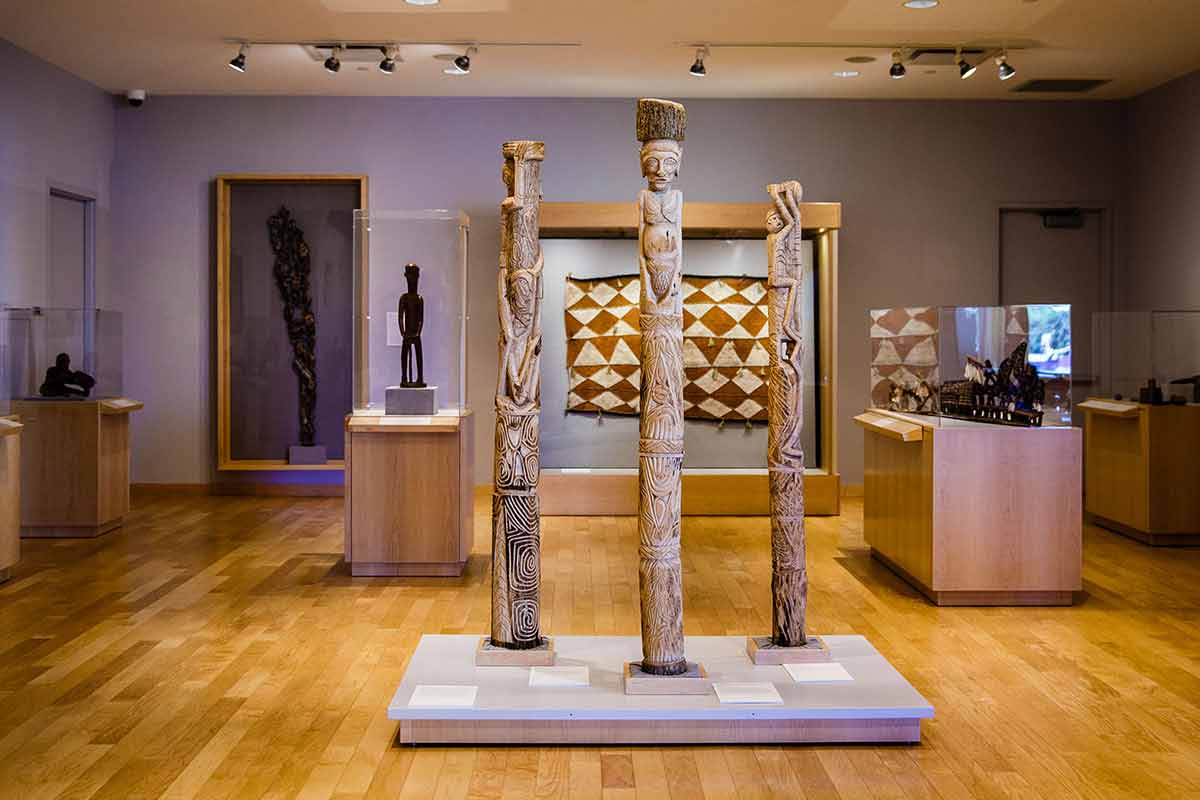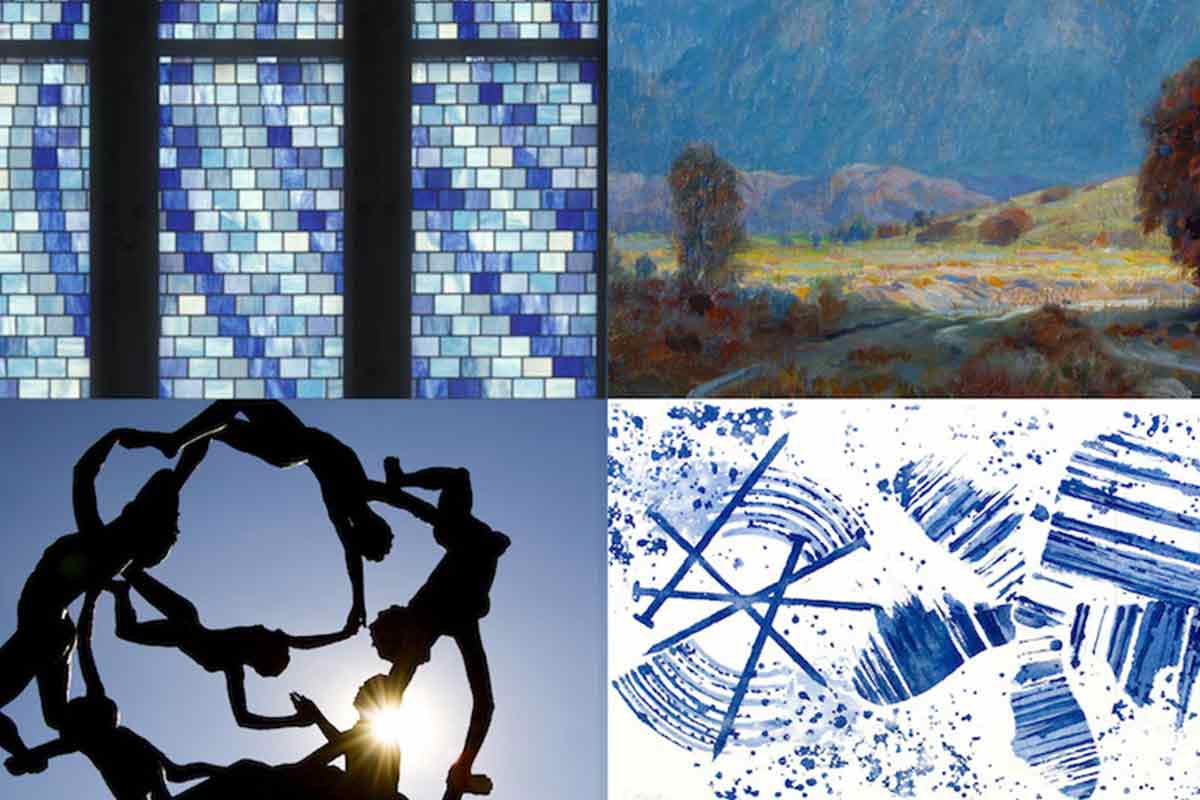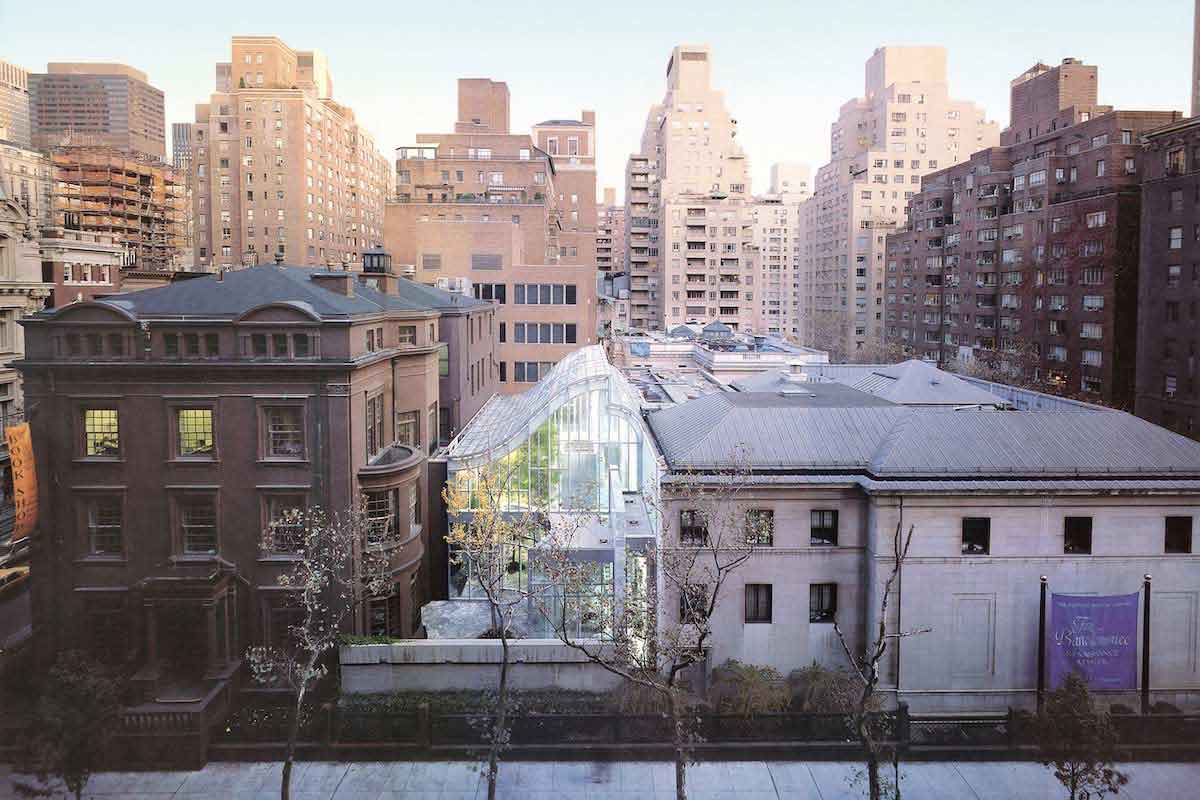Marria Thompson
- Email: marria.thompson@stthomas.edu
- Phone: (651) 962-5877
The art and architectural collections and galleries at the University of St. Thomas serve as teaching opportunities for our students and the public. For undergraduate and graduate students in art history, the VISUAL ARTS@St. Thomas provide the experience of working with artwork, learning proper curatorial and exhibition techniques, and fostering a better understanding of the works' cultural context.
The VISUAL ARTS@St. Thomas include:

The American Museum of Asmat Art is dedicated to expanding human understanding and promoting intercultural awareness through the preservation and exhibition of Asmat art.
The term “Asmat” refers to a people, a language, and a geographic area. Today, Asmat homeland lies within the province of Papua, Indonesia on the southwest coast of the island of New Guinea. Asmat artists are among the finest and most prolific wood sculptors and weavers in the Pacific Islands.
theamaa.org: Visit the American Museum of Asmat Art website for more information.
The AMAA’s collection of Asmat art is one of the largest in North American with nearly 3,000 works. It was originally formed by the American Crosier Father and Brothers, under the leadership of Bishop Sowada who used anthropological approaches to renew cultural traditions and encourage artistic production in Asmat. This Catholic religious Order first arrived in Asmat in 1958 and acquired objects through purchase, trade, and as gifts. In 2007, the collection was given to the University of St. Thomas to educate our community and the broader public about Asmat. The museum opened in 2012 and is on the second floor of the Anderson Student Center on the St. Paul campus.
The American Museum of Asmat Art at St. Thomas engages students and the global community through preserving, exhibiting, and interpreting the art of Asmat people, in order to expand human understanding and promote intercultural awareness.
The vision of the American Museum of Asmat Art at St. Thomas is to be a preeminent teaching collection, interdisciplinary in nature and programmatically diverse, that promotes global understanding of Asmat art and culture consistent with the mission and values of the University of St. Thomas.
The AMAA is divided into two sections. The objects on permanent display include Asmat ancestor poles (bis), a spirit canoe (wuramon), and other large-scale works such as shields and body masks. The rest of the gallery is dedicated to rotating exhibitions based on different aspects of Asmat art and culture.
The AMAA forms an integral part of the University’s broader commitment to foster respect and appreciation for cultural diversity and the artistic achievements of all humanity.
Open to the public and admission is free!
Academic Year Hours
10 a.m. - 4 p.m Tuesday & Wednesday
10 a.m. - 5 p.m Thursday
10 a.m. - 2 p.m Friday
12 p.m. - 4 p.m Saturday
Closed Sunday & Monday
Summer Hours:
10 a.m. - 2 p.m. Tuesday
10 a.m. - 2 p.m. Thursday - Saturday
Closed Sunday, Monday & Wednesday
Scheduled Closings
The AMAA is closed for all major U.S. holidays, St. Thomas breaks, during final exams week, January Term, and in June for installation.
Groups wishing to schedule a visit may contact Gretchen Burau, Museum Director in advance of their visit.
The AMAA is on the second floor of the Anderson Student Center. at the University of St. Thomas.
Street parking is available in non-permit areas along Cretin Avenue and Summit Avenue. Guests are also welcome to park in the Anderson Parking Facility and the Morrison Parking Ramp.
The AMAA’s collection of Asmat art is one of the largest in North American with nearly 3,000 works. It was originally formed by the American Crosier Father and Brothers, under the leadership of Bishop Sowada who used anthropological approaches to renew cultural traditions and encourage artistic production in Asmat. This Catholic religious Order first arrived in Asmat in 1958 and acquired objects through purchase, trade, and as gifts. In 2007, the collection was given to the University of St. Thomas to educate our community and the broader public about Asmat. The museum opened in 2012 and is on the second floor of the Anderson Student Center on the St. Paul campus.
The American Museum of Asmat Art at St. Thomas engages students and the global community through preserving, exhibiting, and interpreting the art of Asmat people, in order to expand human understanding and promote intercultural awareness.
The vision of the American Museum of Asmat Art at St. Thomas is to be a preeminent teaching collection, interdisciplinary in nature and programmatically diverse, that promotes global understanding of Asmat art and culture consistent with the mission and values of the University of St. Thomas.
The AMAA is divided into two sections. The objects on permanent display include Asmat ancestor poles (bis), a spirit canoe (wuramon), and other large-scale works such as shields and body masks. The rest of the gallery is dedicated to rotating exhibitions based on different aspects of Asmat art and culture.
The AMAA forms an integral part of the University’s broader commitment to foster respect and appreciation for cultural diversity and the artistic achievements of all humanity.
Open to the public and admission is free!
Academic Year Hours
10 a.m. - 4 p.m Tuesday & Wednesday
10 a.m. - 5 p.m Thursday
10 a.m. - 2 p.m Friday
12 p.m. - 4 p.m Saturday
Closed Sunday & Monday
Summer Hours:
10 a.m. - 2 p.m. Tuesday
10 a.m. - 2 p.m. Thursday - Saturday
Closed Sunday, Monday & Wednesday
Scheduled Closings
The AMAA is closed for all major U.S. holidays, St. Thomas breaks, during final exams week, January Term, and in June for installation.
Groups wishing to schedule a visit may contact Gretchen Burau, Museum Director in advance of their visit.
The AMAA is on the second floor of the Anderson Student Center. at the University of St. Thomas.
Street parking is available in non-permit areas along Cretin Avenue and Summit Avenue. Guests are also welcome to park in the Anderson Parking Facility and the Morrison Parking Ramp.

By providing both the campus community and the public with access to contemporary and historical art exhibitions, the gallery supports local and regional arts communities and bolsters a wider understanding of artistic engagement with societal issues.
Visit the John P. Monahan Gallery website for more information.
The Monahan Gallery is committed to providing an exhibition program that fosters dialogue centered around the issues of contemporary and historical art and architectural topics to encourage paths of inquiry and intercultural understanding to advance the common good.
Groups wishing to schedule a visit may contact Marria Thompson, University Curator, in advance of their visit.
The John P. Monahan Art Gallery is located on the first floor of the Schoenecker Center at the University of St. Thomas in St. Paul, MN.
Scheduled Closings
The Monahan Gallery is closed for all major U.S. holidays, St. Thomas breaks, January Term, and the summer.
Street parking is available in non-permit areas. Guests may also park in the Anderson Parking Ramp.
The Monahan Gallery is committed to providing an exhibition program that fosters dialogue centered around the issues of contemporary and historical art and architectural topics to encourage paths of inquiry and intercultural understanding to advance the common good.
Groups wishing to schedule a visit may contact Marria Thompson, University Curator, in advance of their visit.
The John P. Monahan Art Gallery is located on the first floor of the Schoenecker Center at the University of St. Thomas in St. Paul, MN.
Scheduled Closings
The Monahan Gallery is closed for all major U.S. holidays, St. Thomas breaks, January Term, and the summer.
Street parking is available in non-permit areas. Guests may also park in the Anderson Parking Ramp.
The Sustainability Arts Gallery is an evolving, living space, continuously activated with new artwork, research, and activities. Over the next two years (2025-2027), join us in exploring the past, present, and future ecology of St. Thomas, the surrounding area, and the Mississippi River through interdisciplinary and indigenous perspectives. Engage with original research by St. Thomas faculty, staff, and students, artwork by local artists, and outdoor experiences to explore the ecosystem around us. We invite you to investigate changing relationships between ecology and community over time and to envision how we can foster interconnected human and ecological well-being now and for the future. Through the integration of research, art, and experiences, this space seeks to deepen our understanding and appreciation of the ecosystems that sustain us and our ability to care for our common home.
Led by Maria Dahmus, Director, Office of Sustainability Initiatives & Marria Thompson, University Curator
The Sustainability Arts Gallery is located on the first floor of the O'Shaughnessy Educational Center (OEC) in St. Paul.
Street parking is available in non-permit areas along Cleveland Avenue and Summit Avenue. Guests may also park in the Tommie East Parking Garage.
The Sustainability Arts Gallery is an evolving, living space, continuously activated with new artwork, research, and activities. Over the next two years (2025-2027), join us in exploring the past, present, and future ecology of St. Thomas, the surrounding area, and the Mississippi River through interdisciplinary and indigenous perspectives. Engage with original research by St. Thomas faculty, staff, and students, artwork by local artists, and outdoor experiences to explore the ecosystem around us. We invite you to investigate changing relationships between ecology and community over time and to envision how we can foster interconnected human and ecological well-being now and for the future. Through the integration of research, art, and experiences, this space seeks to deepen our understanding and appreciation of the ecosystems that sustain us and our ability to care for our common home.
Led by Maria Dahmus, Director, Office of Sustainability Initiatives & Marria Thompson, University Curator
The Sustainability Arts Gallery is located on the first floor of the O'Shaughnessy Educational Center (OEC) in St. Paul.
Street parking is available in non-permit areas along Cleveland Avenue and Summit Avenue. Guests may also park in the Tommie East Parking Garage.
The St. Thomas Art Collection includes the many works of fine art and outdoor sculptures on view throughout campus, as well as numerous other artworks housed within the Department of Art History. The collection represents a variety of regions from around the world, in particular African and Midwestern art.

The University of St. Thomas Art Collection seeks to bring the visual arts to the university, providing an enriching and engaging experience for all students, scholars, and community members. Diverse in scope, the collection fosters critical thinking about global cultures and the material world.
With historical oil paintings, large scale outdoor sculptures, intricate African carvings and more, the University of St. Thomas Art Collection has over 1,500 works of art that you can search and explore.
During Fall 2019, students in Professor Vanessa Rousseau's Museum Studies: Collections (ARTH 250) explored the Greco-Roman coins from the University of St. Thomas Art Collection. This hands-on project allowed the students to work with objects, metadata, and digital exhibitions while creating an online database that serves as a valuable resource for the collection.
The University of St. Thomas Art Collection seeks to bring the visual arts to the university, providing an enriching and engaging experience for all students, scholars, and community members. Diverse in scope, the collection fosters critical thinking about global cultures and the material world.
With historical oil paintings, large scale outdoor sculptures, intricate African carvings and more, the University of St. Thomas Art Collection has over 1,500 works of art that you can search and explore.
During Fall 2019, students in Professor Vanessa Rousseau's Museum Studies: Collections (ARTH 250) explored the Greco-Roman coins from the University of St. Thomas Art Collection. This hands-on project allowed the students to work with objects, metadata, and digital exhibitions while creating an online database that serves as a valuable resource for the collection.
The Voorsanger Architects Archive holds the work of Voorsanger Architects PC, a New York-based architectural firm. The physical archive focuses on highlights of the design and creative process from initial sketches to final photos of the firm's various projects, as well as items relating to Principal and founder Bartholomew Voorsanger, FAIA.
A curated collection of 25 projects was selected as representative of the firm's work from the 1970s through the 2010s. Quick facts on these selected projects are showcased on the archive website, while the archive database offers more detailed information and documentation on each of the 25 selections.

American Museum of Asmat Art
Voorsanger Architects Archive